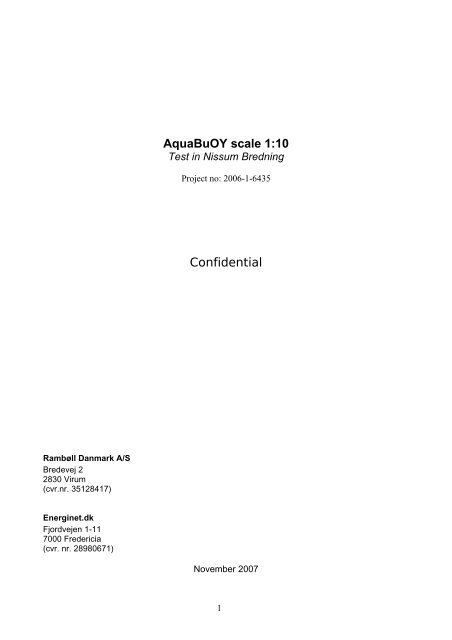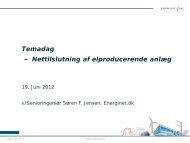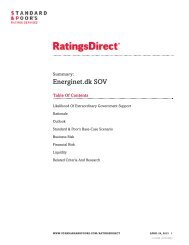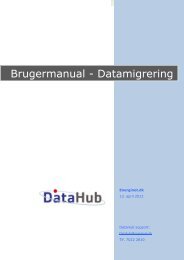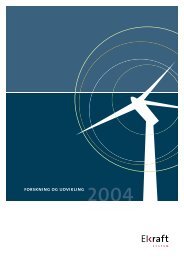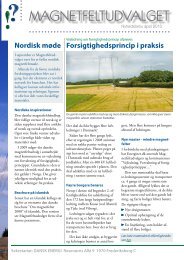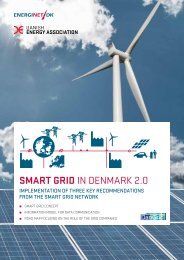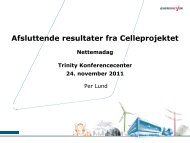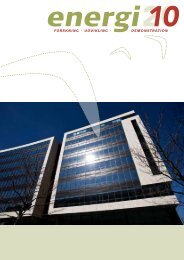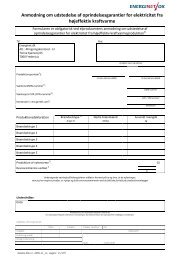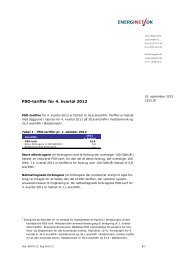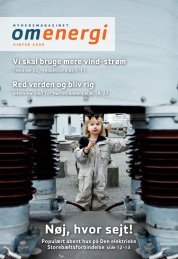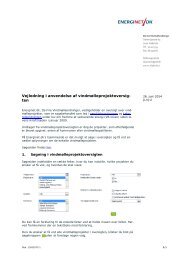AquaBuOY scale 1:10 - Energinet.dk
AquaBuOY scale 1:10 - Energinet.dk
AquaBuOY scale 1:10 - Energinet.dk
Create successful ePaper yourself
Turn your PDF publications into a flip-book with our unique Google optimized e-Paper software.
<strong>AquaBuOY</strong> <strong>scale</strong> 1:<strong>10</strong>Test in Nissum BredningProject no: 2006-1-6435ConfidentialRambøll Danmark A/SBredevej 22830 Virum(cvr.nr. 35128417)<strong>Energinet</strong>.<strong>dk</strong>Fjordvejen 1-117000 Fredericia(cvr. nr. 28980671)November 20071
Content:Introduction:.................................................................................................................................... 2History of the project...................................................................................................................... 2Scope and Objectives..................................................................................................................... 4Conclusions .................................................................................................................................... 4Choice of Scale and test site ........................................................................................................4Choice of model Fabrication and Material ..................................................................................5Choice of end-stop solution the by-pass section..........................................................................6Choice of Instrumentation of the 1:<strong>10</strong> <strong>scale</strong> model .....................................................................7Methodology used installing of the <strong>scale</strong> model in Nissum Bredning ...................................... 8Results and conclusion................................................................................................................ <strong>10</strong>Parallel research projects ............................................................................................................ 11Testing of the Hose-pump..........................................................................................................111:50 Scale Experiment HMRC Cork .........................................................................................12Prototype testing Oregon USA ..................................................................................................13
Introduction:This R&D project involves building a 1:<strong>10</strong> <strong>scale</strong> model of an <strong>AquaBuOY</strong> wave energy converter and followedby open sea testing at the test site in Nisum Bredning on 6.5 meter deep water.The experiment has been designed to demonstrate the function and power generation of the <strong>AquaBuOY</strong> andthus validate the numerical model. In addition the tests provides AquaEnergy and Ramboll with valuablepractical experience prior to larger <strong>scale</strong> testing.The full <strong>scale</strong> <strong>AquaBuOY</strong> has a diameter of 7 meter and is projected to generate about 250 kW in sea statesof Hs = 5m installed on a water depth of approximately 60 meter. Further optimization is anticipated in laterand parallel stages of the product development program.History of the projectDuring the Swedish wave energy programme in the early 1980 th the company Technocean was created todevelop wave energy in Sweden. Driving forces behind Technocean was a multidisciplinary team ofresearchers from Chalmers University such as professor Lasse Bergdahl, Jan Forsberg og Bengt-OlafSjöström og Lennart Claeson and others [1].During the years 1979 to 1981 the Swedish company Interproject Service IPS in cooperation withTechnocean developed and tested a wave power converter the “IPS Buoy” outside Götenborg in the opensea. The IPS converter is described in [2] and some of the results in [3].The research within Technocean lead to another concept called the “Hose pump project” developed incooperation with the large Swedish company Svenske Varv. The Hose pump project consisting of four floatswas also tested outside Götenborg pumping high pressure water to a small pelton turbine placed on shore.The Swedish wave energy programme ended around 1986 and cooperation between IPS and Technoceancontinued and Gunner Fredrikson CEO of IPS maintained patents. In co-operation with Bengt Olaf theypatented in 1999 the incorporation of hose-pumps in the IPS buoy “the <strong>AquaBuOY</strong>”.Ocean Tested IPS Buoy Ocean Tested Hose Pump AquaEnergy's <strong>AquaBuOY</strong>2
During the period 1992 – 1996 I was co-ordinator of the EU project OWEC-1, where both IPS andTechnocean was included as project partners along with most of the leading European wave energy experts.During this project I developed in co-operation with ES-Consult numerical models for the two Swedish waveenergy projects the IPS and the Hose-pump project, which had many similar features to the point absorberssystem developed by Danish Wave Power.Gunnar Fredrikson´s two sons Göran and Hans live in USA. Hans´s introduced his colleague Alla Weinsteinto his father to realise the wave energy project in USA. Alla Weinstein got via Gunnar Fredriksen contact withBengt-Olaf and started the company AquaEnergy in USA to develop the project together with her brotherYuiri.In 2001 Bengt Olaf Sjöström og Yuiry died in a plane crash, as their little airplane crashed while surveyingthe ocean area of Makaha Bay in the north westerly corner of USA, where they planned to build a waveenergy plant.In addition to the tragic personal losses also the project expertise was lost. Only the remains of the laptopfrom Bengt Olaf was found washed up on the beach some months later.Gunnar Fredriksen from IPS recommended Alla Weinstein to initiate a co-operation between AquaEnergyand Ramboll with the aim to reconstruct the numerical model of the <strong>AquaBuOY</strong> and further development.This cooperation and development started in 2002 and filled in a void for Ramboll regarding wave energy asthe Danish wave energy programme just had terminated due to change of government in 2001.The development has in the five-year period since 2002 evolved through different stages with private as wellas public financial support.oooooooooooAquaEnergyRambollAalborg UniversityDunlopBlack&VeatchEFP, DKCarbontrustSEIUCC<strong>Energinet</strong> DKFinevera RenewablesAs a result of AquaEnergy´s search for private investment Finavera Renewables bought AquaEnergy in2006. Finavera thereby introduced the economical recourses necessary to build the first large prototype ofthe <strong>AquaBuOY</strong> that was deployed in Oregon USA September 2007.Kim Nielsen, November 20073
Scope and ObjectivesooooTo build a sufficiently large physical model of the <strong>AquaBuOY</strong> (<strong>scale</strong> 1:<strong>10</strong>) suitable to validate andinvestigate the interaction of the device components.To obtain preliminary experience with the principles of operating the model in a sea environment,regarding installation, mooring, survivability and maintenance.To provide a comparison between the measured and the calculated (projected) performanceparameters for selected sea states conditions.Assess viability of the use of the drag reduction components such as placement of a “bulb” below theacceleration tube to reduce the fluid friction.ConclusionsThe <strong>scale</strong> 1:<strong>10</strong> project has provided valuable learning experience and sufficient confidence in theconstruction and operating principles of the <strong>AquaBuOY</strong> to support the design and deployment of a half <strong>scale</strong>prototype of the AquaBuoy.Incorporating the experience from the <strong>scale</strong> 1:<strong>10</strong> project the company Finevera Renewables haveconstructed and successfully deployed a prototype of the <strong>AquaBuOY</strong> of the coast in Oregon USA.The development of the <strong>AquaBuOY</strong> is a multinational co-operation and valuable interaction has taken placebetween parallel research projects and the 1:<strong>10</strong> <strong>scale</strong> design process.Choice of Scale and test siteDuring the Marine Energy Challenge development programme in the UK – <strong>AquaBuOY</strong> was one amongseveral wave energy converters offered the possibility of UK engineering expertise in assessment of designand to further optimize the performance. Based on the calculated power production in the Orkney waveclimate 28kW/m the study showed the optimal dimensions for the <strong>AquaBuOY</strong> at this site dimensions are asfollows:Float diameter:Float draught:Tube lenght:Tube diameter:Rated Absorbed Power:7 meter4,8 meter30 meter4,65 meter273 kW (in wave conditions Hs = 5m & Tz = 7,5 sec)A 1:<strong>10</strong> <strong>scale</strong> model means that a converter of identical geometry, but <strong>10</strong> times smaller in all lineardimensions can be tested in waves also ten times smaller in height and <strong>10</strong> 0,5 = 3,2 times smaller in waveperiods.The power delivered from the <strong>scale</strong> model in the <strong>scale</strong>d rated conditions will be <strong>10</strong> 3,5 times smaller comparedto full <strong>scale</strong>.Thus results from a model can be <strong>scale</strong>d up using Froudes model law and thus results from a smallexperiment can be used to predict the performance of a larger geometrical identical system in <strong>scale</strong>d up seaconditions.The testing in Nissum Bredning was selected as this site previously had been used for <strong>scale</strong> testing ofsystems like the Wave Dragon, Wavestar and the other systems. The test site Nissum Bredning with4
significant wave heights up to about 1 meter compares well to a <strong>scale</strong> test of 1:<strong>10</strong> and this ratio was chosenfor the test.Physical dimensions:Parameter Model Scale factor Full <strong>scale</strong><strong>10</strong>Float diameter 0,7 meter <strong>10</strong> 7Float height 0,48 meter <strong>10</strong> 4,8Displaced volume 185 litre <strong>10</strong> 3 185 m 3Accelerator tube diameter 0,46 meter <strong>10</strong> 4,65 meterAccelerator tube length 3 meter <strong>10</strong> 30 meterRated absorbed Power 86 watt <strong>10</strong> 3,5 273 kWSignificant wave height (at rated power) 0,5 meter <strong>10</strong> 5 meterAverage wave period (at rated power) 2,3 seconds <strong>10</strong> 0,5 7,5 secondsChoice of model Fabrication and MaterialThe <strong>scale</strong> model is constructed in PVC and build by Brønnum Plast using as far as possible standard tubedimensions as shown on the photo below. The lower bulb on the tube was designed to reduce the dragresistance of the heave motion.The PVC model of the <strong>AquaBuOY</strong> in <strong>scale</strong> 1:<strong>10</strong>,Left: the float and the by-pass section,Right: the lower part of the acceleration tube with the bulb below.5
Choice of end-stop solution the by-pass sectionThe bypass mechanism was invented by IPS to avoid overload on the linear power take-off in case thecenter piston moved outside its working area. The by-pass solution consisted of a working area for the pistonwith a slightly smaller diameter compared to the tube diameter. In case the piston moved out the workingarea water could flow pass the piston and reduce the end-stop loads. The construction parts are shown inthe photo below and the assembled section below. The piston is attached to a central guide-rod. This designturned out to take up quite a lot of length in the tube – and a different was developed for the half <strong>scale</strong>prototype.The piston (black) in its working area just beneath the by pass area.6
Choice of Instrumentation of the 1:<strong>10</strong> <strong>scale</strong> modelFollowing the 1:50 <strong>scale</strong> experiments in Cork, Ireland, in the spring 2007 (page 12) it was decided toincorporate a similar mechanical power take-off on the 1:<strong>10</strong> <strong>scale</strong> model as shown oh the picture below.AquaEnergy/Finavera subcontracted the instrumentation and testing of the model to Aalborg University anda separate report describing the instrumentation is enclosed [4].The power take of based on mechanical components is shown onthe photo to the left. The PTO could be mounted on top of the float.At the top is a friction element that combined with the springsprovides the damping characteristics close to that of the hosepumps.Measurements of the piston displacement relative to the float, theload on the rod and the motion of the float.The instrumentation includesoooLoad cellPosition sensorTri-axial accelerometerBased on the force measured and the relative velocity of the piston(derived from the relative position measurements) the averagepower absorbed over a period of time can be calculated as:T1Pmech = F(t)vr( t)dtT∫0F(t)v r (t)TForce in rod connectionRelative velocity between piston and floatMeasurement periodThe measurements are stored in a data handler box on the floatpowered by batteries placed in a separate container next to thefloat.7
Methodology used installing of the <strong>scale</strong> model in NissumBredningThe system was tested in Nissum Bredning (Denmark) and a small team from Aalborg University installedthe <strong>scale</strong> model July 22 2007, from Oddesund in the early morning in very calm water. The installation wasdone within 3 hours.Transportation at seaFloat moored between three mooring buoys.In the days to come the forecast was rough windy weather with wind directions from west and south west.The predicted waves at the site based on measured wind data is shown in the report from Aalborg Universityand within the next few days wave conditions in terms of significant wave height was increasing up to 0,7meter (highest waves about 1,4 meter).8
The following week on July 28 the Aalborg team observed the model in wave conditions calculated to Hs =0,7 meter with average wave periods of about 3 seconds. The team estimated that the model had problemsas it was observed to be leaning to one side as shown on the photo below.Observation of the float July 28 2007The following inspection on July 30 verified the suspicion as the model was stranded on the beach.Float ashore on July 30 2007It appeared that a structural failure in the upper flange connecting the float to the tube had taken place. Thefloat had tilted to a horizontal position. The connecting fins had cut the mooring lines and the float strandedon the beach. Weeks later the lower part of the tube was also recovered and removed from the beach.9
Results and conclusionThe 1:<strong>10</strong> <strong>scale</strong> project has made it possible to investigate different design solutions with respect toincorporation of power take off system and testing equipment in small <strong>scale</strong> as well as the design of the endstop by-pass solution for the piston.The practical experience showed that even in the relative small <strong>scale</strong> the model needed to be handled withgreat care to avoid damage. The PVC material is fragile and sensitive to impact loads and the bolting flangesbetween the sections in the acceleration tube appeared to be relatively weak compared to the overallstrength of the model when placed horizontal for transportation.The placement of ballast in order to obtain the correct metacenter height also showed some difficulty due tothe light weight of the PVC structure. It was finally decided to place the sand ballast in the hull (about 80 kg)to obtain the correct water line. Even though the model was operating vertical in heave when installed – theinitial tilting of the model showed that the sand could move resulting in a sloped angel of the centerline.The installation was very easy and could be carried out within a few hours in calm weather.Following the installation the weather changed and for 2 weeks the waves made it impossible with theavailable transportation means to access the devise. Observations made by AAU after one week showedthat the model was not floating vertical but leaning to one side. After two weeks the lower part of theacceleration tube had broken off – the mooring lines had been cut and the model could be picked up on thebeach.The data handler box with stored measurements appeared empty and data from the experiment could not beretrieved.Concluding and looking back on the experience of this exercise it appears that a number of further initialtasks could have been incorporated to ensure a better performance.ooIn the case of this system initial tests of the structure could probably have revealed if the boltingsections needed further reinforcement – or pretension by wires.Dry test of measuring equipment and data collection system combined with a setup to activate thePower take off on land could probably have provided a better understanding of why no data wasobtained.The main practical experience from the 1:<strong>10</strong> <strong>scale</strong> model tests however has given sufficient confidence inthe operation of the device and the experience and knowledge gained has supported the development of the<strong>AquaBuOY</strong> i.e. shown areas where a redesign was needed, such as a redesign of the bypass system toallow better support for the piston and at the same time provide sufficient length to incorporate the hoseswithin the length of the acceleration tube.<strong>10</strong>
Parallel research projectsTesting of the Hose-pumpDynamic testing of the hose-pump was realized at a test rig build at AEAT in the UK, with the support fromthe UK Carbon trust and Dunlop as lead partner. Three different hose constructions were tested. The resultsdemonstrated an efficiency of around 75% in converting mechanical power into hydraulic power. The testsalso showed that fatigue was a problem that needed further research in order to construct hoses withsufficient long operating life. The test showed that the construction induced rotation that after a few monthscaused failure of the hose at its termination. A principle to reduce the rotation by adjusting the applied anglesof reinforcement in different layers of the hose was proposed and incorporated in the design.Hose being tested at the test rigThe theory for the pump regarding flow and pressure for different strokes and periods was verified. Andfatigue tests followed.Dynamic test rig for testing the hose pump – AEATInitially for the 1:<strong>10</strong> project the PTO was proposed to be composed of similar rubber hoses – produced byFesto Practical considerations and detailed design regarding these small hoses however revealed that evenif they in theory could provide the required damping, incorporating two opposing sets within the length of theacceleration tube was not possible. Further the flow resistance through the standard fittings would generateexcessive flow losses and make the power measurements difficult without additional measurementequipment. Sea testing of hoses was therefore postponed to larger <strong>scale</strong> testing.11
1:50 Scale Experiment HMRC CorkTo verify the performance and optimize the AquBuOY Finavera/AquaEnergy was funded through the Irishgovernment Sustainable Energy Ireland SEI, to conduct 1:50 <strong>scale</strong> testing at HMRC, Cork, Ireland.The testing and preparation of result took place in January - March 2007. The model tests helped calibrateand validate the numerical model developed by Ramboll. Further the principles of the PTO for experimentaltesting was changed from hydraulic to a mechanic system including springs and friction. The combination ofsprings and friction turned out to provide very similar characteristics as the forces from the hose-pumps. Itwas agreed to incorporate this PTO system in the 1:<strong>10</strong> <strong>scale</strong> testing also.The 1:50 <strong>scale</strong> model ready for testing at HMRCThe main results from the 1:<strong>10</strong> <strong>scale</strong> model experiments were data produced on performance for a widerange of sea states and damping settings. The numerical model was improved by incorporating of moreaccurate hydrodynamic parameters for the combined float and tube geometry as well as drag resistancemeasured experimentally.The comparison between measured and calculated energy production showed an overall good agreement.The numerical model was transferred from Ramboll to Finavera as part of this project to be used in furtheroptimization an evaluation. The results are described in a confidential report as part of the SEI project.12
Prototype testing Oregon USADuring the spring and summer of 2007 the design and building of the 1:2 <strong>scale</strong> model took place in OregonUSA by companies hired by Finavera renewable. The speed and efficiency in getting the project up andrunning was quite remarkable seen with European eyes. Only about one and a half month after the projectmanager Denis from USA had been witnessing the installation of the 1:<strong>10</strong> <strong>scale</strong> system in Nissum Bredning,he was ready to install the 1:2 <strong>scale</strong> model on the west coast of the USA September 1 2007.<strong>AquaBuOY</strong> 1:2 construction and prototype testing in USA, Oregon September 2007 [5]13
References:[1] Energi från havets vågor, Lennart Claeson mfl, Technocean AB, 1987[2] First Symposium on Wave Energy Utilization, 30 October –1 November 1979[3] Proceedings of the 2 nd International Symposium on Wave Energy Utilisation, The Norwegian Institute ofTechnology, Trondheim Norway June 22-24, 1982[4] <strong>AquaBuOY</strong> Wave Energy Converter, real sea testing at Nissum Bredning Denmark September 2007,Dep. of Civil engineering, Aalborg University[5] Finaveras webpage www.finavera.com14


